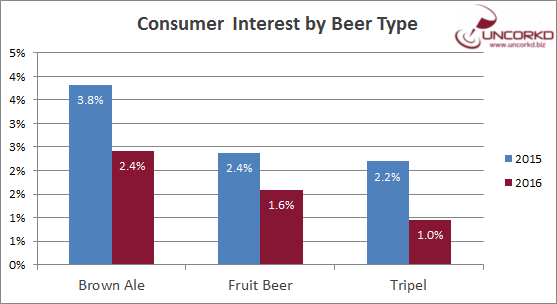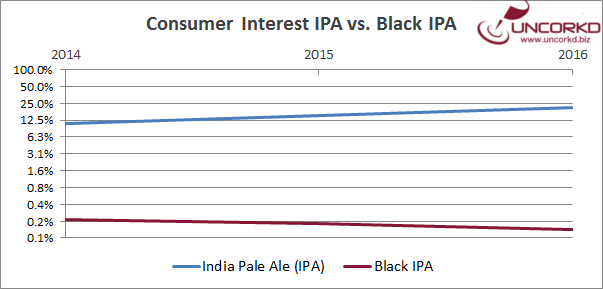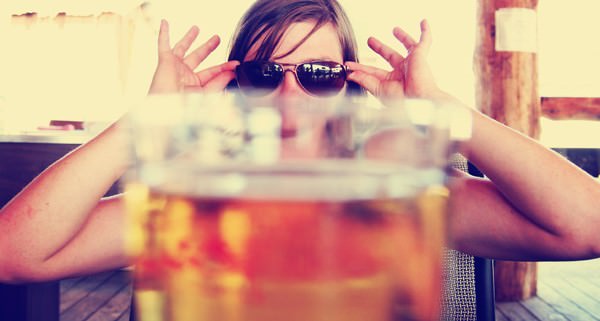Menu Study Shows What Kinds of Beers Restaurants Should Stop Selling
The craft beer market has exploded. Even toddlers and teetotalers are aware of this. This explosion has left a beer industry pock marked with craters and rumbling tremors have reshaped its landscape. But while the craft beer market is constantly being explored and its trends teased out, it is too often talked about as a single unit. But in fact, the beer market, like all alcohol markets, is actually split in two: on-premise and off-premise. As restaurant and bar operators look at beer trends, it’s important to note the distinctions between consumer interest trends in retail and liquor stores (off-premise) and restaurant and bars (on-premise). In an effort to add nuance to the zeitgeist, Uncorkd has analyzed it’s restaurant menu data and broken down millions of data points to see what trends have the best chance to increase sales and have impact in restaurants and bars.
At Restaurants, More is Less
This is in regards to alcohol by volume. Though beers with high ABV numbers are certainly a hit with craft beer drinkers, as the trend of IPAs with alcohol hovering around 6.65%, and full bodied barrel-aged beers are certainly trendy and available in increasing abundance, consumer interest for lower-ABV beers has stayed consistent in restaurants. This is especially true during spring and summer months, as drinkers are looking for lighter beers offering refreshing flavors and drinkability during hotter months and al fresco consumption.
Key Take Away: Interest in beers with low ABV hits its peak during the spring and summer months. It’s important to keep this in mind as you rotate seasonal lists. Not only is their a shift in style preference, but alcohol volume as well. This should be relatively easy to keep up with as breweries release seasonal labels that usually fall in line with this drinking trend.
High ABV? Don’t be Sweet About It

According to Uncorkd menu data, consumer interest for Brown Ales, Fruit Beers, and Belgian-style Tripel ales have all dropped significantly this past year. Brown ales have dropped in interest by -37%, while Fruit beers have dropped -33% and Tripels have seen the largest drop in interest at -57%.
It’s important to note that these three styles tend to have a higher malt content in their recipes which leads to high ABV. According to a chart put together by Brewer’s Friend using data supplied by the non-profit Beer Judge Certification Program, all three of these beer styles fall on the higher end of the ABV scale within their respective beer categories.
It is also worth noting, that in terms of flavor, these three beers tend to be sweeter styles, again, drawing this characteristic from the higher malt quantities used in their recipes.
Key Take Away: Beer styles that are both sweet and high in alcohol are loosing consumer interest. Though IPAs often have ABVs within the same range of the above mentioned beers, the different ingredients, and volume of ingredients like hops that result in dry, bitter, or crisp flavors, add balance to malt sweetness and ultimately result in more consumer friendly beers.
Digital menu data drives smart decisions. Download the Uncorkd Digital Menu Brochure
Not All IPA Styles Are Trending

Though interest for IPA-style beers have grown significantly over the past three years, and makes up 20% of consumer interest, not all sub-styles of IPAs have experienced increased interest. In particular, consumer interest in Black IPAs has declined during the same time frame.
Black IPAs fall into a category where guidelines for the style have been historically unclear. They are often referred to as Black Ales, and the two terms are generally used interchangeably. The Brewer’s Association added style guidelines for Black Ales in 2011, and beers that boast the label of Black IPA fall under this category. There isn’t a clear reason why Black Ales have dropped in popularity at restaurants. But when looking at ABVs of beers considered Black Ales, it’s clear see that a trademark of this style is that these are heavy, highly alcoholic beers. Many entries in this category fall into the 8-10% ABV range. According to the Black Ale style guideline referenced above, Black Ales should fall between 6.3%-7.6% ABV. When Uncorkd took a look at Beer Advocates list of the most reviewed Black Ales, the average ABV for the top 100 reviewed beers was 7.59. This is at the highest end of the ABV spectrum for this style.
When Uncorkd looked at the most common ABVs for beers in restaurants, the average was 5%, with the beers most commonly falling between 4.6%-5.4% ABV, which is well below 7.59%.
Why Is Lower ABV a Dominant Trend For On-Premise Drinkers?
Well, it’s hard to say exactly why without admitting to some speculation. But a few things that quickly come to mind are as follows:
- Drinking away from home requires a commute. While cities are flush with options like public transit, taxis, and ride sharing, commuting and drinking high ABV beers can be an issue for people who rely on their own cars for transport.
- When looking at full service restaurants, higher alcohol beers will be heavier and more filling, and might not be ideal for diners pairing beer with a meal
- There is still a significant market share dominated by macro-produced beers that are predominantly low-ABV lagers, and have the benefit of being familiar options for many drinkers
If you work in the beer industry or for a restaurant chain and would like to purchase our full report on consumer interest for beer that dissects the data much further, email us at sales@uncorkd.biz.
Of course existing Uncorkd customers have access to this and other customized reporting for free. Visit our website to learn more about our iPad beer menus.
- 5 Fall Cocktails to Capture the Flavors of Autumn - September 26, 2018
- How Restaurants Can Ignore Sales and Increase Profits - May 9, 2018
- 2018 Spring Wine Trends - April 18, 2018



